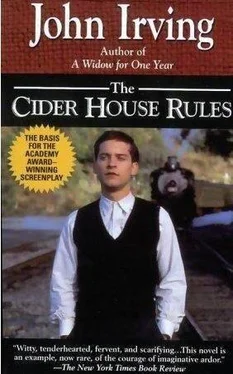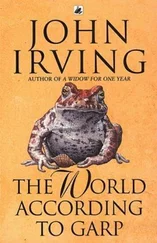John Irving - The Cider House Rules
Здесь есть возможность читать онлайн «John Irving - The Cider House Rules» весь текст электронной книги совершенно бесплатно (целиком полную версию без сокращений). В некоторых случаях можно слушать аудио, скачать через торрент в формате fb2 и присутствует краткое содержание. Жанр: Современная проза, на английском языке. Описание произведения, (предисловие) а так же отзывы посетителей доступны на портале библиотеки ЛибКат.
- Название:The Cider House Rules
- Автор:
- Жанр:
- Год:неизвестен
- ISBN:нет данных
- Рейтинг книги:5 / 5. Голосов: 2
-
Избранное:Добавить в избранное
- Отзывы:
-
Ваша оценка:
- 100
- 1
- 2
- 3
- 4
- 5
The Cider House Rules: краткое содержание, описание и аннотация
Предлагаем к чтению аннотацию, описание, краткое содержание или предисловие (зависит от того, что написал сам автор книги «The Cider House Rules»). Если вы не нашли необходимую информацию о книге — напишите в комментариях, мы постараемся отыскать её.
Dr Larch loves all his orphans, especially Homer Wells. It is Homer's story we follow, from his early apprenticeship in the orphanage, to his adult life running a cider-making factory and his strange relationship with the wife of his closest friend.
The Cider House Rules — читать онлайн бесплатно полную книгу (весь текст) целиком
Ниже представлен текст книги, разбитый по страницам. Система сохранения места последней прочитанной страницы, позволяет с удобством читать онлайн бесплатно книгу «The Cider House Rules», без необходимости каждый раз заново искать на чём Вы остановились. Поставьте закладку, и сможете в любой момент перейти на страницу, на которой закончили чтение.
Интервал:
Закладка:
(pp 66-7) A Caesarean section is, today, a relatively calm operation: the abdominal incision is small because the uterus is opened inside the abdominal cavity. But in Dr. Larch's days at the Boston Lying-in, in 188- and 189-, the incision made in the abdominal wall was nearly a foot long; the uterus was lifted through the incision and placed upon the patient's abdomen. 'The slashing of this great, plum-colored organ produced a dramatic gush of liquid and blood,' my grandfather wrote. The uterus was then sutured with silk and returned to the abdominal cavity; the abdomen was closed in the same way. Considerably more discomfort followed such an operation than follows a Caesarean section now. The operation, in Larch's time-and without complications -would require nearly an hour.
(p 70) This death by scurvy is based on an actual case: 'The Strange Case of Ellen Bean,' as told by my grandfather. 'A spinster of thirty-five years and of New England stock,' Grandfather wrote of Ms. Bean, whose condition (and cause of death) was the same fate I awarded to the unfortunate Mrs. Earnes. As my grandfather wrote: The pregnant state does not engender in all women the rapturous joy traditionally associated with this condition; indeed, there are some who view their 723 future with a sour visage and a jaundiced eye. This much may be assumed from the case of Ellen Bean.'
(p 70) In Wilbur Larch's own state, in dear old Maine, performing an abortion was punishable by a year in jail or a one-thousand-dollar fine, or both-and, if you were a doctor, you might lose your license to practice. The Eastman-Everett Act of 1840 described the attempted abortion of any woman with child as an offense, 'whether such child be quick or not'-and regardless of the method.
(p 72) Instead of red merthiolate Dr. Larch might have used Dakin's solution, although it's likely he would have learned more about its uses during his short visit to France in World War I. That is where my grandfather learned of the many uses of Dakin's solution and where he learned how to débride -that is, to cut away all the devitalized tissue surrounding a wound; the French were good teachers of this, he said.
(pp 75-83) In order for Dr. Larch to find the music in the 189-, abortion palace 'remindful of Mahler's Kindertotenlieder,' he would have to be gifted with a little precognition; Mahler's song cycle was written in 1902. That is implied in the line, 'Of course they could not have been singing Mahler's Songs on the Death of Children, but those were the songs Wilbur Larch had heard.'
(p 83) This is my grandfather's description of the condition of an actual patient, an extreme!)' small woman named Edith Fletcher-upon whom a Caesarean section was performed (Boston Lying-in Hospital; July 13, 1894). A pelvis this small is rare.
(pp 84-5) Mrs. W. H. Maxwell's A Female Physician to the Ladies of the United States: Being a Familiar and Practical Treatise of Matters of Utmost Importance Peculiar to Women ('Adapted to Every Woman's Own Private Use') was published in New York in 1860. Mrs. Maxwell treated 'all diseases peculiar to women, or which they may have unfortunately incurred through the dissipations or wanton unfaithfulness of husbands, or otherwise.' {724}(In short, she treated venereal diseases.) Mrs. Maxwell also wrote that she gave her attention, as well, 'to women… who are forced by the malfunction of their genital organs, or other cause, to resort to premature delivery.' (In short, she performed abortions.)
(p 128) The New England Home for Little Wanderers was originally The Baldwin Place Home for Little Wanderers; the charter was granted by the Commonwealth of Massachusetts in 1865. The name was changed to The New England Home for Little Wanderers, its present name, in 1889-more than a decade before Wilbur Larch founded the orphanage in St. Cloud's.
(p 141) In a 1928 gynecology textbook (Howard Kelly-the standard at that time), the term D and C is used. I think it's safe to assume that the term was in common use in 192-.
(p 141) My grandfather said that he needed to use his Gray's Anatomy in France in World War I as a 'navigational chart.'
(pp 151) This is the exact description of a D and C as viewed by Dr. Richard Selzer (Yale School of Medicine), a general surgeon and author (Mortal Lessons: Notes on the Art of Surgery and Rituals of Surgery are among his books). I'm grateful for his reading of the manuscript of this novel and his generous advice-especially his introducing me to Dr. Nuland, who was the overseer of all the medical aspects of this novel.
(p 167) The source of my information concerning the physical and mental manifestations of Alzheimer's disease is The Journal of the History of Medicine and Allied Sciences, Volume XXXIV, Number 3, July 1979: the article by Dr. Sherwin B. Nuland, 'The Enigma of Semmelweis-An Interpretation.' Dr. Nuland first presented his material in a lecture at the Yale School of Medicine (the annual History of Surgery Series). His thesis is that Ignac Semmelweis, the tortured discoverer of the sources of puerperal fever, suffered from Alzheimer's disease and not from neurosyphilis; furthermore, Dr. Nuland {725} believes that Semmelweis died of injuries received in a mental institution-i.e., he was beaten to death by his keepers. The records of Bedlam and of other institutions for the insane show that this was common as late as the early part of this century, and occasional reports still appear.
(pp 166-7) The source of the description of Homer Wells's first eclampsia patient is my grandfather's book Safe Deliverance -the chapter on puerperal convulsions. Grandfather examines the case of a Lucy Nickerson, who died in 1880 of an eclamptic condition that.was further aggravated by a forced delivery-the only method known to physicians of the unfortunate Mrs. Nickerson's day.
(pp 168) The source of this treatment is again my grandfather, Dr. Frederick C. Irving (he was called Fritz). Grandfather describes this as the correct and lifesaving treatment given to one Mrs. Mary O'Toole in 1937.
(p 174) As of 1942, these are my grandfather's findings. Syphilis-although a great source of agitation to the public-health officials of the day-afflicted only 2 percent of the pregnant women of Boston. The incidence of eclamptic convulsions was much higher. The disease developed in 8 percent of the country's childbearing women.
(p 197) Spring would be considered too early to bother waxing the press boards; the first press wouldn't be until September, when you'd be pressing the early Mclntoshes and the Gravensteins. The press boards, or racks, are wooden slats, over which the cider cloths (or press cloths) are folded. The press boards-they are stacked seven-high -take quite a beating, and the wax protects them. The mash, which is also called the pomace, is squeezed between these boards under a pressure of two thousand pounds. It takes eight hours to squeeze a thousand gallons of cider out of the press-about three gallons per bushel of apples.
The reason you wax the press boards before: the first press is that you don't want to take the time to do it once the 726 harvest has begun. And you're running the cider mill during the harvest maybe as much as every other night, and every day that it rains-when you can't pick apples. In the 1940s and the 1950s, the last good press would have come in January.
I'm indebted to my old friends Ben and Peter Wagner and to their mother, Jean, for this and other applefarming information. The Wagners run the Applecrest Farm Orchards in Hampton Falls, New Hampshire, where I worked when I was a boy; Jean and her late husband, Bill, gave me my first job.
(p 198) All orchards have names; it is common practice, too, for farmers to name their buildings. This is necessary for the shorthand language of simple directions, as in: 'The Deere has a flat and needs fixing in the Frying Pan'; or, 'I left the Dodge in Number Two because Wally is spraying in the Sanborn and he'll need a ride back.' In the orchard where I worked, there was a building called Number Two-although there was no Number Three and I don't remember a Number One. Many of the orchards were named after the families who'd been the original homesteaders on that particular piece of land (Brown, Eaton, Coburn, and Curtis are some local names I remember). There was an orchard called Twenty Acres and another one called Nineteen, and there were the plainer names-an orchard called the Field, one called the Fountain, one called the Spring, and one called Old-New (because it was half old trees and half newly planted). The Frying Pan is also called Frying Pan-without the article.
Читать дальшеИнтервал:
Закладка:
Похожие книги на «The Cider House Rules»
Представляем Вашему вниманию похожие книги на «The Cider House Rules» списком для выбора. Мы отобрали схожую по названию и смыслу литературу в надежде предоставить читателям больше вариантов отыскать новые, интересные, ещё непрочитанные произведения.
Обсуждение, отзывы о книге «The Cider House Rules» и просто собственные мнения читателей. Оставьте ваши комментарии, напишите, что Вы думаете о произведении, его смысле или главных героях. Укажите что конкретно понравилось, а что нет, и почему Вы так считаете.












